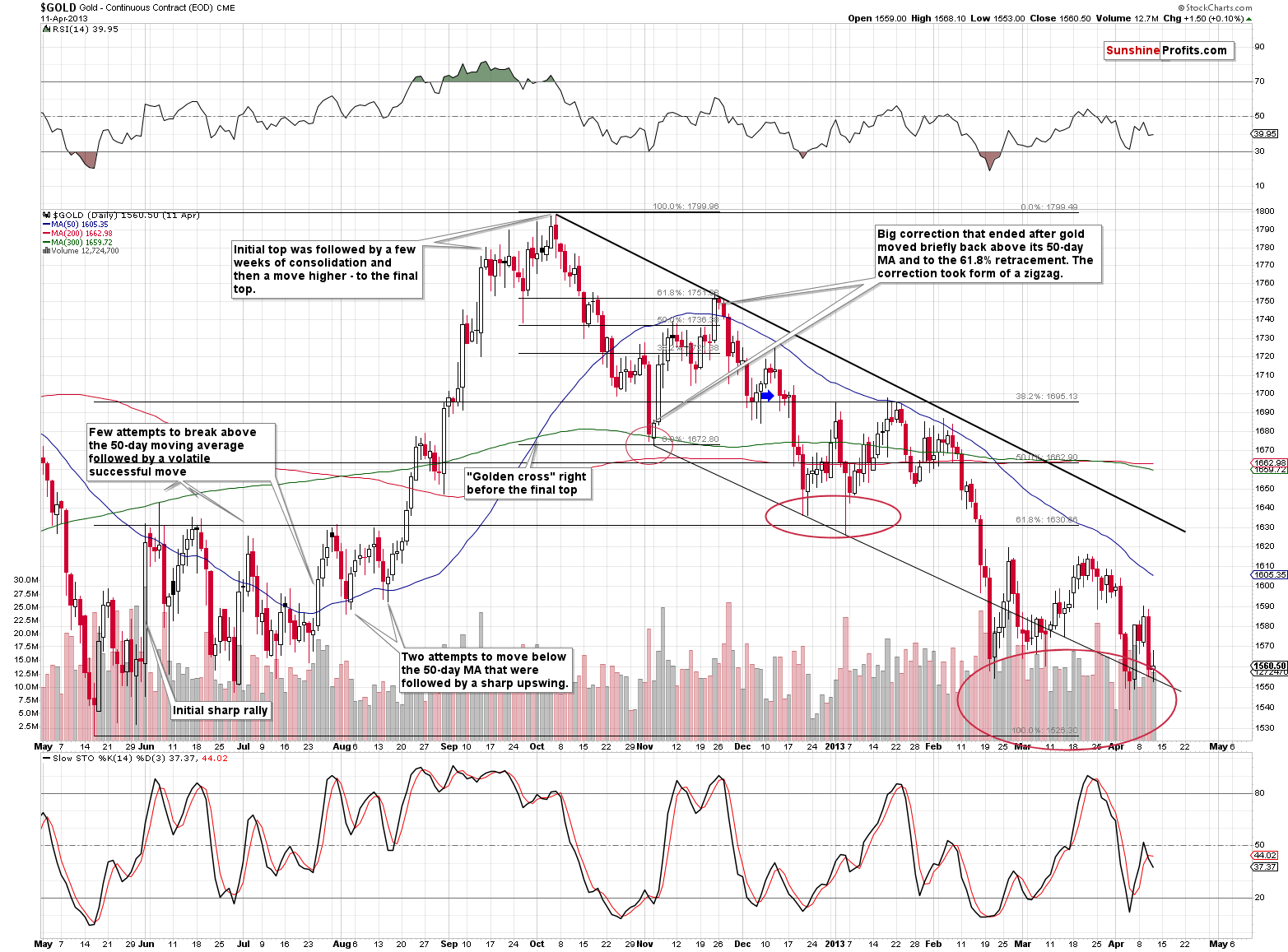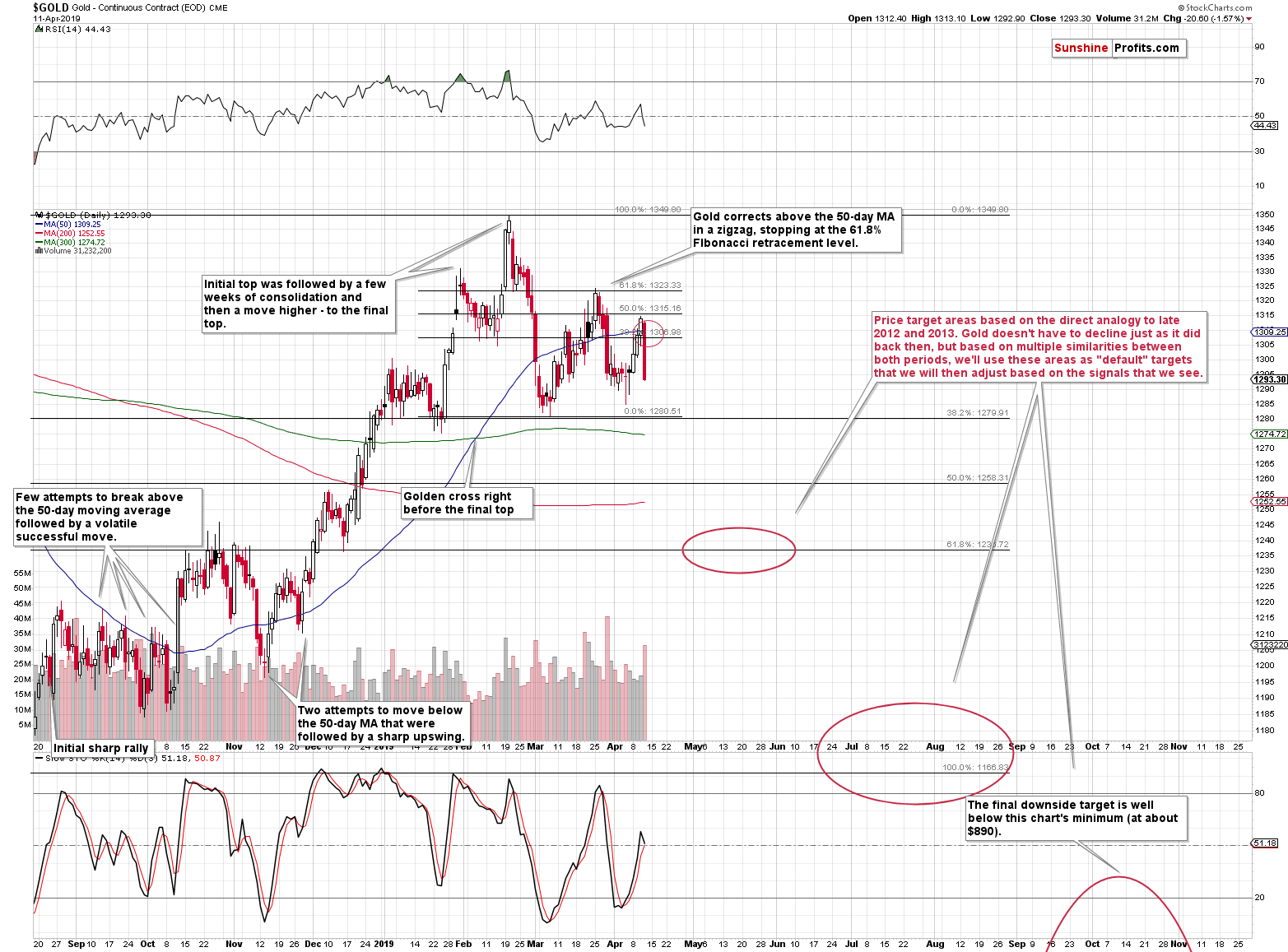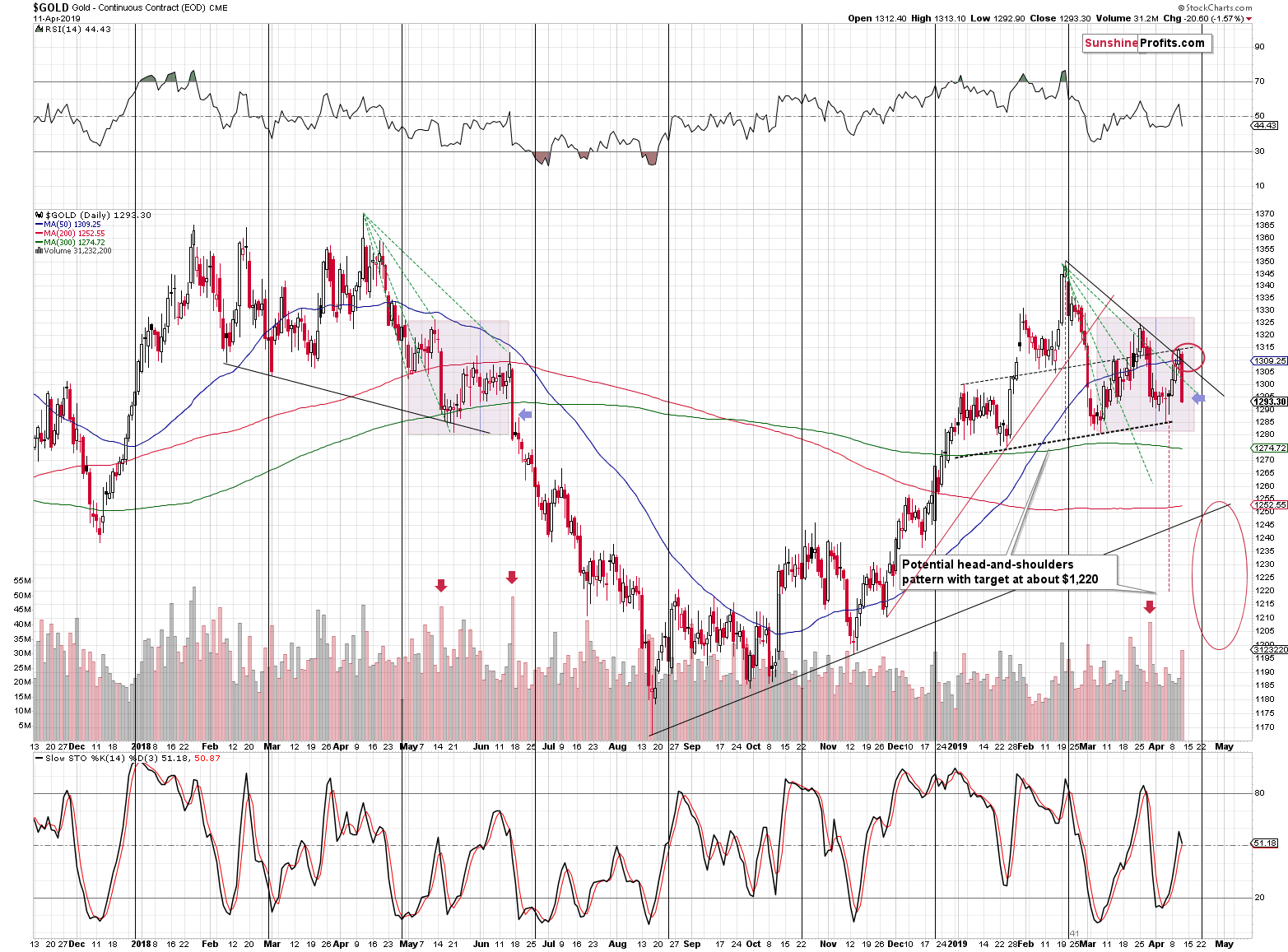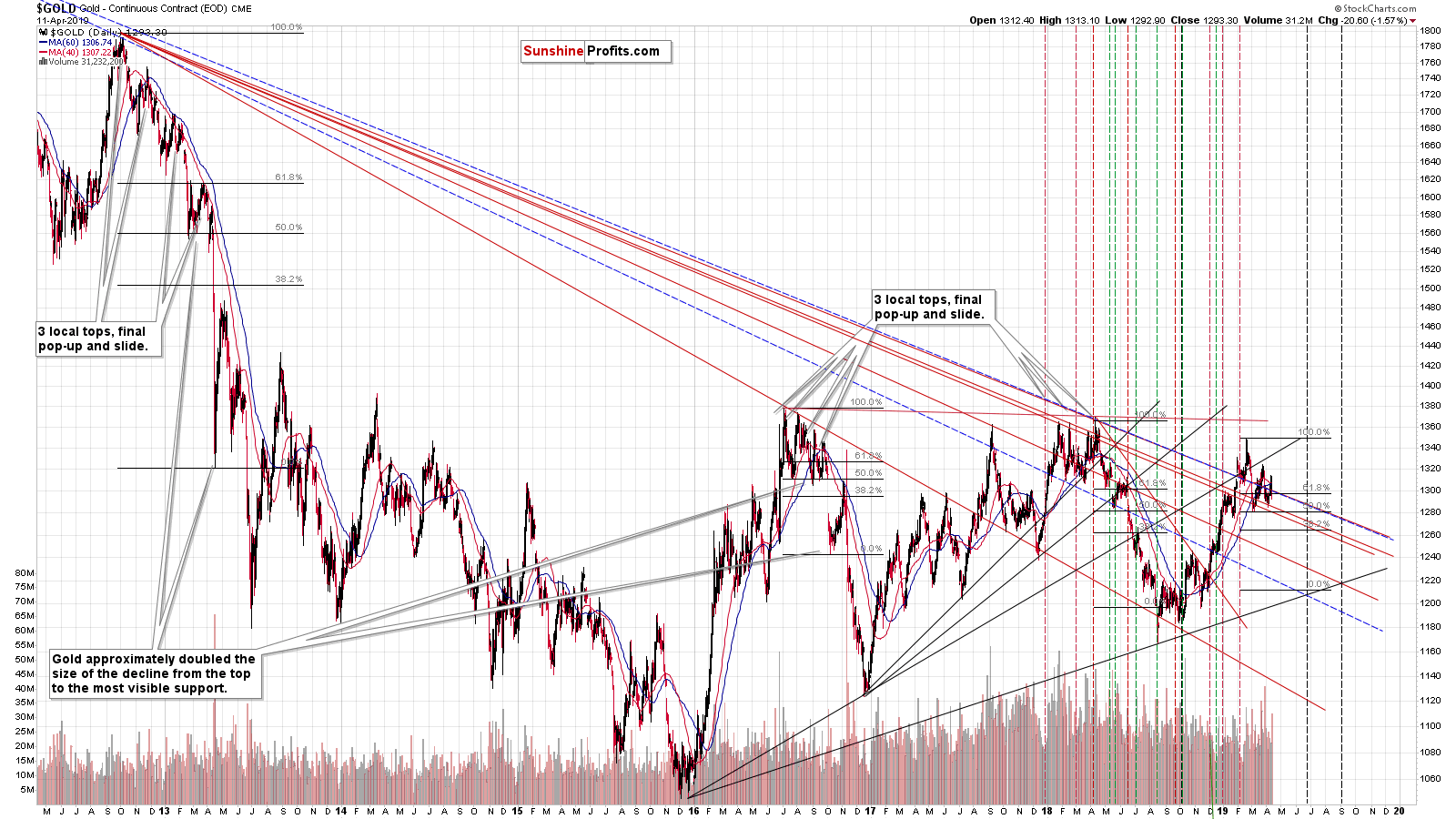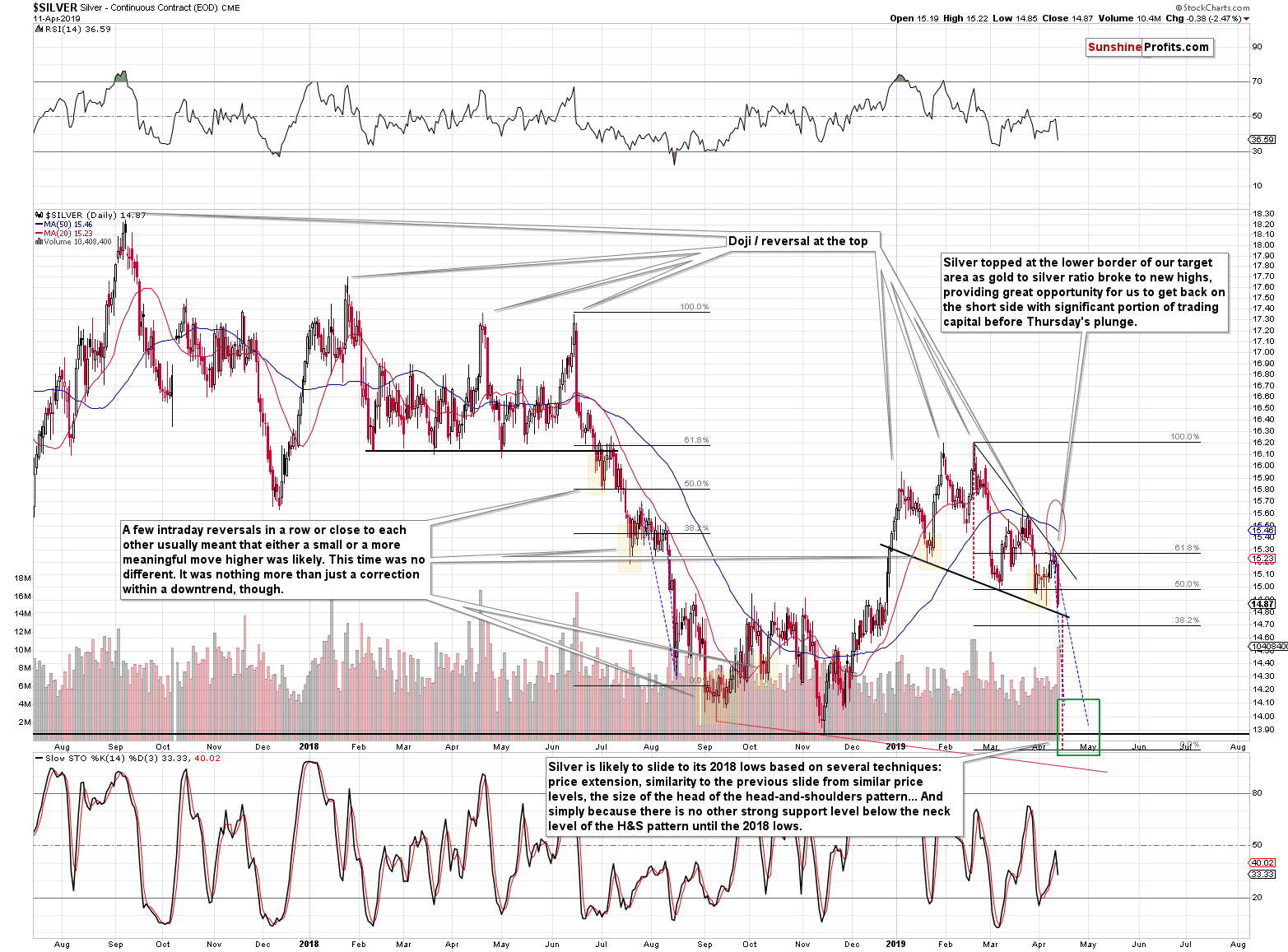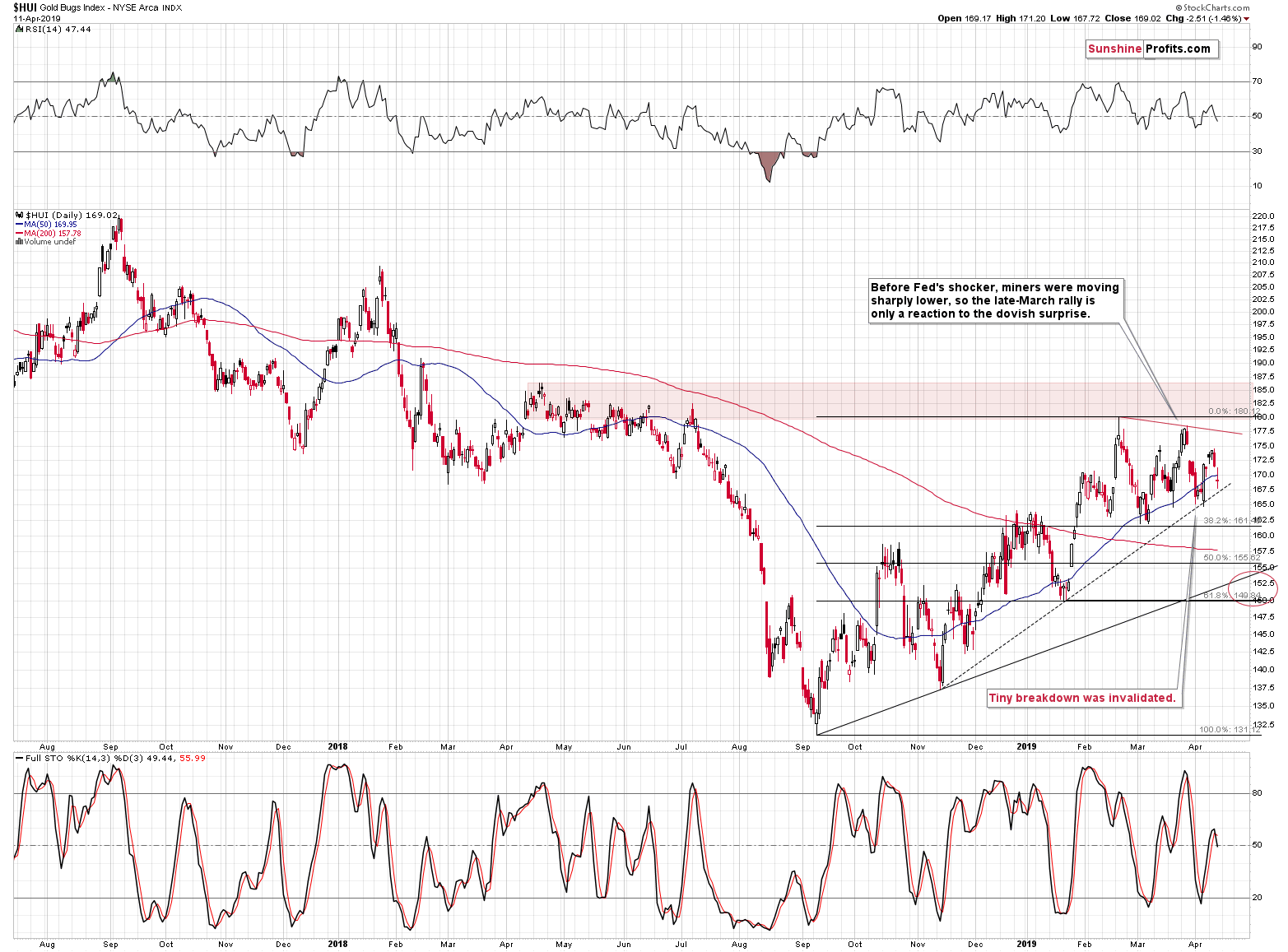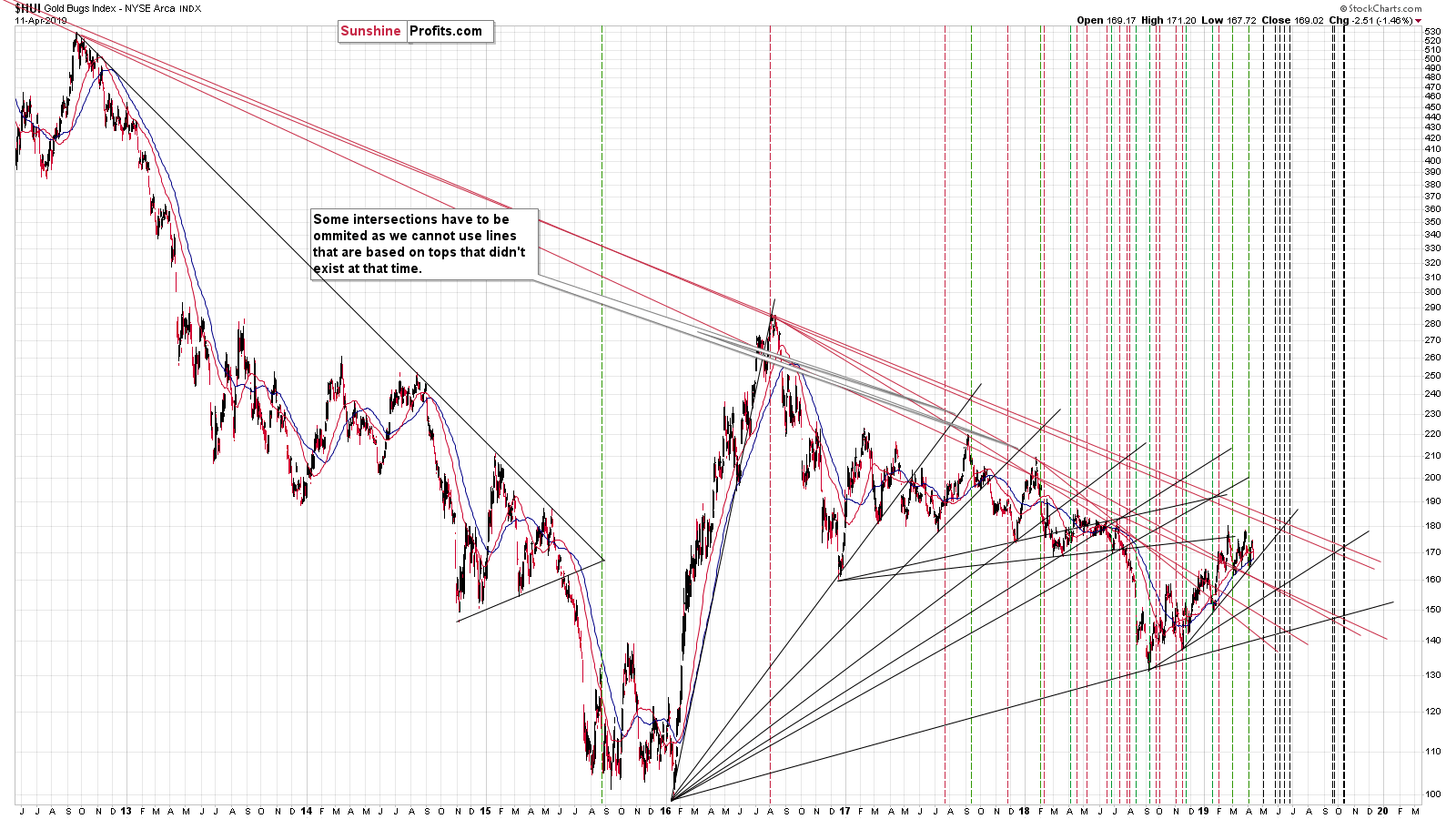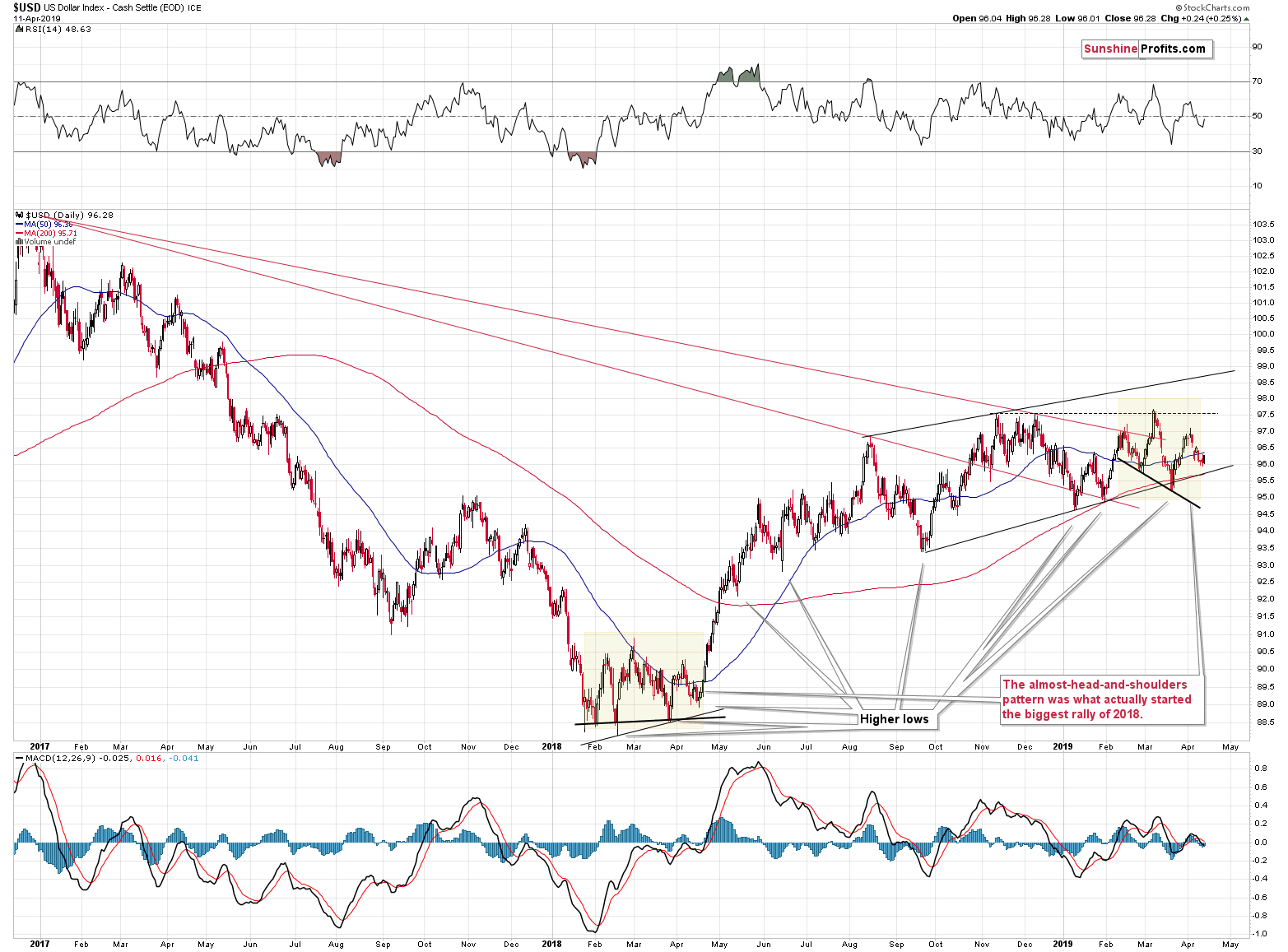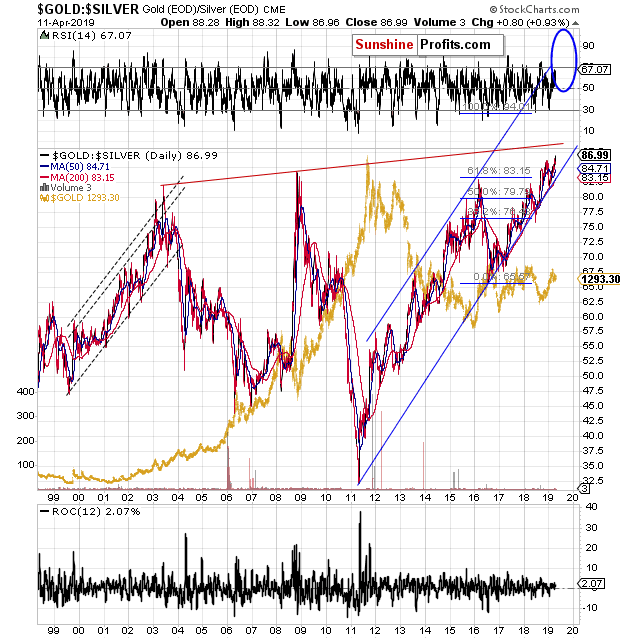Briefly: in our opinion, full (250% of the regular size of the position) speculative short position in gold, silver, and mining stocks is justified from the risk/reward perspective at the moment of publishing this Alert. We are moving all take-profit levels and silver's stop-loss levels.
Gold declined and silver plunged. Gold to silver ratio temporarily spiked to 88. And you know that it's not shocking or surprising - it's all unwinding just like it was likely to. Applying the techniques that successfully detected the recent corrective upswing and its end, to what we have right now, provides us with price and time targets for the next bottom. It might even be a buying opportunity.
Let's start with gold. Both analogies that we recently commented on, tell us that gold is likely to slide, if not immediately then in a couple of days, but they provide limited clarity with regard to the bottoming price. The link between what's going on now and what happened in 2012-2013 points to about $1,240 at the target price.
Gold's Two Analogies
We previously noted that the early December upswing had ended with a reversal during which gold had almost reached the 50-day moving average. This time, gold moved slightly higher, but the tiny moves above the 38.2% Fibonacci retracement and the 50-day moving average were invalidated shortly. The link to how gold performed in 2012 clearly remains in place and it's quite odd that we're the only ones that noticed it.
Just like what we saw in December 2012 during the first post-correction decline day (we marked it with a blue arrow), yesterday's move took gold almost to the previous lows, but not below them. In December, what followed were 2 days of pause and then the decline accelerated. Something similar could very well take place this time. In fact, it's already taking place. Gold is doing next to nothing, which is in perfect tune with what happened previously. It's not bullish - it's normal.
The next major target is $1,240, because it's the rounded proximity of the 61.8% Fibonacci retracement ($1,237). That's the level that triggered a corrective upswing in late 2012 and early 2013. This technique is quite reliable for the gold market in general, but the above analogy gives it even greater credibility.
We wrote about two analogies in gold, so let's move to the second one.
The second analogy is to the mid-2018 decline. The decline accelerated once it broke below the nearest support line and the previous lows. In 2018, it happened in June. We are not yet at this stage, but we are very close. We marked the similar days with blue arrows.
Based on the above analogy, we can expect gold to slide until it reaches the previous important bottom. The nearest important bottom is at about $1,200 (formed in November 2018). There are also two smaller bottoms that might also trigger a temporary reversal: the late-November bottom at about $1,210 and the mid-December bottom at about $1,236. The latter is very close to the previously mentioned 61.8% Fibonacci retracement, which gives it more credibility than the remaining levels.
There's also the head-and-shoulders formation that will come into play once gold breaks below the neck level. It's relatively close - at about $1,285, so gold would need to decline by only $8 from yesterday's close to reach it. The target based on this formation is created by applying the size of the "head" to the moment and price of the breakdown. This technique points to $1,220 as the likely target for gold.
Of course, there's also the rising support line that's based on the August and November 2018 lows and it points to $1,250 as the likely near-term target.
How to Play Gold's Decline
Applying the price extension technique suggests that gold might move to about $1,215 before forming a short-term bottom.
On Tuesday, we commented on the above chart in the following way:
The first rule is that there are three tops before the decline really starts. There's also a smaller correction and that's pretty much it - then gold just drops.
The early-2013, September 2016, and May 2018 upswings were all the above-mentioned "smaller corrections" after which gold took a dive.
In 2019, the late-January top, the late-February top, and the late-March top were the three tops as per the above-mentioned rule. What we're seeing now is likely the final "smaller correction" after which gold is likely to take a dive.
The second rule is that an important intermediate bottom takes place at the price that we get by doubling the size of the initial volatile drop. On the above chart, we applied this rule by using the Fibonacci retracements in a non-standard way. The starting point is the top (for instance the 2012 top) and the second point that we use is the initial bottom (February 2013 bottom) to which we apply the 50% Fibonacci retracement. The end of the Fibonacci tool shows where gold would need to be in order to double the initial the decline.
This technique worked in all three major declines that we see above: the initial 2013 slide, the late-2016 decline, and the 2018 decline. The important thing is that this technique doesn't necessarily point to the final bottom - just an intermediate one.
In case of the current situation, this technique points to about $1,215 as the next downside target.
Consequently, we have quite a few near-term targets for gold that range from $1,200 to $1,250. Based on the way gold declines, it will be more likely or less likely that there will either be a single bigger correction or a few smaller ones. For instance, in mid-2018 there were two moderate corrections during the downswing - one took place in early July and the other in mid-July. If gold plunges to $1,200 in a sharp manner without looking back, we'll likely have a bigger correction. The volatile slide would represent a very emotional move and traders would need to cool down before being ready for another wave lower.
But, if gold declines steadily, it's likely to correct a few times in an insignificant manner. The former outcome would provide a good trading opportunity, but the latter would probably not.
What's the best course of action here? To wait and see how gold declines, while at the same time looking for clues also from other markets. Fortunately, both: silver and mining stocks provide more coherent targets.
The Hints from Silver and Mining Stocks
Silver is almost at the neck level of its own head and shoulders pattern, which points to the target of about $13.80. That's about $1 below yesterday's closing price. It's a lot, but let's keep in mind that silver is known for volatile price drops, so a $1 decline would not be all that uncommon.
The 2018 bottom at about $13.90 is a natural target candidate as it provides strong support. The September and late-November 2018 bottoms formed at about $14.10, which is also an important support level.
The next technique is the analogy to the previous decline from approximately the current levels - the one that we saw in August 2018. If silver repeats its August 2018 performance, it's going to reach $13.95 - $14.10. It's not a precise target, but an area, because we can use the late-July 2018 top as the starting point of the previous decline, or the early-August top.
Finally, we have a price extension technique combined with the analogy to the entire mid-2018 decline. Back then, silver doubled its initial (June) decline. The initial bottom formed a bit above the 200% price extension based on the initial decline, and the second bottom formed a bit below it. The price extension points to $13.80 as the next target, just like the head-and-shoulders pattern that we discussed above.
Which of these levels is most likely? The $13.80 level, but using the $14 - $14.10 area seems better for trading purposes. After all, it's not worth risking the entire trade for just about 20 cents.
If silver slides to the 2018 low in a sharp manner - which is quite likely - then the follow-up rebound might also be volatile. The mid-August bottom and the following sharp rebound serve as a good example.
Gold and silver are close to their support lines and we can say the same thing about the gold miners. Once they break lower, their next short-term target is at about 150 - 152.5. The upper part of this target area is confirmed by the rising support line, while the lower part is confirmed by the mid-January bottom and the 61.8% Fibonacci retracement based on the entire decline.
The prices are only one part of the prediction. There's also the issue of time. On the third chart from this Alert, you can see that gold's next cyclical turning point is just around the corner. There's also the hint from the gold stocks' triangle-vertex-based turning points.
The next reversal based on this technique is scheduled for late April or early May.
Looking at the shape of silver's mid-2018 decline (the green blue dashed lines on the silver chart), we get the prediction that silver should move lower and bottom between the next few days and about 3 weeks.
The same goes for gold's analogy to the 2012-2013 decline. Taking into account the moment that's analogous to the current one, we see that gold then declined for another 1-3 weeks. The initial bottom was formed in a week and the final short-term one was formed in 3 weeks (2 weeks after the initial one).
Overall, the precious metals sector is likely to reverse (and likely form a temporary bottom) close to the end of April or in early May.
The USD Index Update
The USD Index moved only a little higher yesterday, and that was enough to trigger the decline in the PMs. Interestingly, the USD index gave away the entire yesterday's rally and then declined some more in today's pre-market trading. But did gold and silver soar? No. Gold is up by mere $0.60. The precious metals market really wants to decline - it seems that it just can't wait for more signals. Gold and silver are ignoring USD's declines while magnifying the reaction to its rallies. That's one of the most bearish situations for the PMs that we can get.
Before summarizing, let's take a look at the gold to silver ratio.
Gold to Silver Ratio Update
The ratio temporarily moved to 88 yesterday, which is a clear sign that the breakout has been confirmed, and the ratio can now move much higher. We received a message about this ratio from one of our subscribers and it seems that our reply might benefit everyone, so here you are.
Thank you once more for your analysis. Probably one of the your most sharp analysis yet on silver. You've been providing many reasons over time to hold on long term purchase of silver and it seems that the stars should align when silver will reach its buying ultimate point when the gold silver ratio will approach 100, when SIL will double bottom @ around 14. I believe it should happen around 10$/ounce. It's my guess which correspond to 200 Months Moving Average of Gold @1020usd. As I mentioned earlier, the probability that gold stay below 1000$ is very low.
We are also thankful for the message and we agree with almost all of the above points. There will most likely be a much better time to invest in silver for the long run than at the current moment. We do think that the white metal will soar well above the previous $50 top, but not before it declines significantly first. The gold to silver ratio is likely to reverse at 100 and this is quite likely to correspond to the final bottom and buying opportunity. While gold may not stay below $1,000 for long (and silver below $10), the move below these levels could be very volatile. Both price levels are very round, and it will generate a lot of attention. Everyone and their brother (even the non-financial press) will likely comment on how bad investments gold and silver are. And very initially this is likely to generate a wave of selling that pushes their prices to their final lows. At some point everyone considering selling will have done so, and the buyers will take over. The bottom will be in and it will be THE buying opportunity. Perhaps the buying opportunity of a lifetime.
As far as SIL is concerned, we wouldn't be surprised to see it even below the 2016 bottom of $14. Gold is likely to break below its previous lows. Silver is likely to break below its own lows very soon (it seems that it's ready to test them shortly). And the gold stocks are likely to slide as well. The latter are underperforming gold on a medium-term basis, so if gold moves below its 2015 bottom, the gold miners most likely also will. If everything else is declining and breaking below the previous lows, why would silver stocks be likely to show enough strength and resist? In our view, they won't manage to do that. And that's actually good, because this would provide even greater opportunity to buy into the silver miners at extremely discounted prices.
Summary
Summing up, the small corrective upswing in the precious metals sector is over and the medium-term downtrend has likely resumed. Based on the likelihood of seeing a temporary turnaround in the next 1-3 weeks, we are moving the profit-take levels higher in order to take advantage of a possible sudden decline.
To summarize:
Trading capital (supplementary part of the portfolio; our opinion): Full short position (250% of the full position) in gold, silver, and mining stocks is justified from the risk/reward perspective with the following stop-loss orders and exit profit-take price levels:
- Gold: profit-take exit price: $1,252; stop-loss: $1,357; initial target price for the DGLD ETN: $50.97; stop-loss for the DGLD ETN $39.87
- Silver: profit-take exit price: $14.11; stop-loss: $15.72; initial target price for the DSLV ETN: $36.97; stop-loss for the DSLV ETN $26.97
- Mining stocks (price levels for the GDX ETF): profit-take exit price: $20.41; stop-loss: $24.17; initial target price for the DUST ETF: $24.28; stop-loss for the DUST ETF $15.47
In case one wants to bet on junior mining stocks' prices (we do not suggest doing so - we think senior mining stocks are more predictable in the case of short-term trades - if one wants to do it anyway, we provide the details), here are the stop-loss details and target prices:
- GDXJ ETF: profit-take exit price: $29.62; stop-loss: $35.67
- JDST ETF: profit-take exit price: $52.32 stop-loss: $30.97
Long-term capital (core part of the portfolio; our opinion): No positions (in other words: cash)
Insurance capital (core part of the portfolio; our opinion): Full position
Whether you already subscribed or not, we encourage you to find out how to make the most of our alerts and read our replies to the most common alert-and-gold-trading-related-questions.
Please note that the in the trading section we describe the situation for the day that the alert is posted. In other words, it we are writing about a speculative position, it means that it is up-to-date on the day it was posted. We are also featuring the initial target prices, so that you can decide whether keeping a position on a given day is something that is in tune with your approach (some moves are too small for medium-term traders and some might appear too big for day-traders).
Plus, you might want to read why our stop-loss orders are usually relatively far from the current price.
Please note that a full position doesn't mean using all of the capital for a given trade. You will find details on our thoughts on gold portfolio structuring in the Key Insights section on our website.
As a reminder - "initial target price" means exactly that - an "initial" one, it's not a price level at which we suggest closing positions. If this becomes the case (like it did in the previous trade) we will refer to these levels as levels of exit orders (exactly as we've done previously). Stop-loss levels, however, are naturally not "initial", but something that, in our opinion, might be entered as an order.
Since it is impossible to synchronize target prices and stop-loss levels for all the ETFs and ETNs with the main markets that we provide these levels for (gold, silver and mining stocks - the GDX ETF), the stop-loss levels and target prices for other ETNs and ETF (among other: UGLD, DGLD, USLV, DSLV, NUGT, DUST, JNUG, JDST) are provided as supplementary, and not as "final". This means that if a stop-loss or a target level is reached for any of the "additional instruments" (DGLD for instance), but not for the "main instrument" (gold in this case), we will view positions in both gold and DGLD as still open and the stop-loss for DGLD would have to be moved lower. On the other hand, if gold moves to a stop-loss level but DGLD doesn't, then we will view both positions (in gold and DGLD) as closed. In other words, since it's not possible to be 100% certain that each related instrument moves to a given level when the underlying instrument does, we can't provide levels that would be binding. The levels that we do provide are our best estimate of the levels that will correspond to the levels in the underlying assets, but it will be the underlying assets that one will need to focus on regarding the signs pointing to closing a given position or keeping it open. We might adjust the levels in the "additional instruments" without adjusting the levels in the "main instruments", which will simply mean that we have improved our estimation of these levels, not that we changed our outlook on the markets. We are already working on a tool that would update these levels on a daily basis for the most popular ETFs, ETNs and individual mining stocks.
Our preferred ways to invest in and to trade gold along with the reasoning can be found in the how to buy gold section. Additionally, our preferred ETFs and ETNs can be found in our Gold & Silver ETF Ranking.
As a reminder, Gold & Silver Trading Alerts are posted before or on each trading day (we usually post them before the opening bell, but we don't promise doing that each day). If there's anything urgent, we will send you an additional small alert before posting the main one.
Thank you.
Sincerely,
Przemyslaw Radomski, CFA
Editor-in-chief, Gold & Silver Fund Manager


